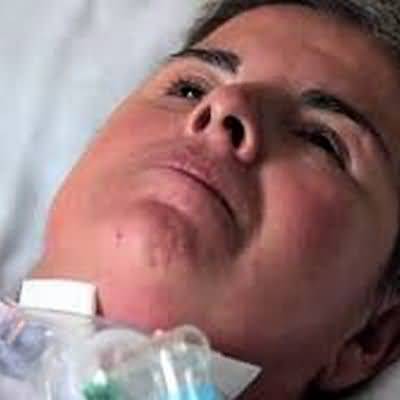squamous cell carcinoma of the larynx
squamous cell carcinoma of the larynx
ESSENTIALS OF DIAGNOSIS
General Considerations
Squamous cell carcinoma of the larynx, the most common malignancy of the larynx, occurs almost exclusively in patients with a history of significant tobacco useSquamous cell carcinoma is usually seen in men aged 50–70 years; an estimated 13,150 new cases in both sexes (10,490 in men) will be seen in United States in 2018
There may be an association between laryngeal cancer and HPV type 16 or 18 infection, but this association is much less strong than that between HPV 16 or 18 and oropharyngeal cancer
In both cancer types, the association with HPV seems to be strongest in nonsmokers
Laryngeal cancer is very treatable and early detection is the key to maximizing posttreatment voice, swallowing, and breathing function
Clinical Findings
A change in voice quality is most often the presenting complaint, although throat or ear pain, hemoptysis, dysphagia, weight loss, and airway compromise may occur
Because of their early impact on vocal quality, glottic cancers are among the smallest detectable human malignancies and treatment success is very high with early lesions
Neck metastases are not common in early glottic (true vocal fold) cancer in which the vocal folds are mobile, but a third of patients in whom there is impaired fold mobility will also have involved lymph nodes at neck dissection
Supraglottic carcinoma (false vocal folds, aryepiglottic folds, epiglottis), on the other hand, often metastasizes to both sides of the neck early in the disease
Complete head and neck examination, including laryngoscopy, by an experienced clinician is mandated for any person with the concerning symptoms listed under Essentials of Diagnosis
Radiologic evaluation by CT or MRI is helpful in assessing tumor extent
Imaging evaluates neck nodes, tumor volume, and cartilage sclerosis or destruction
A chest CT scan is indicated if there are level VI enlarged nodes (around the trachea and the thyroid gland) or level IV enlarged nodes (inferior to the cricoid cartilage along the internal jugular vein), or if a chest film is concerning for a second primary lesion or metastases
Laboratory evaluation includes complete blood count and liver biochemical tests
Formal cardiopulmonary evaluation may be indicated, especially if partial laryngeal surgery is being considered
All partial laryngectomy candidates should have good to excellent lung function and exercise tolerance because chronic microaspiration may be expected following the procedure
A positron emission tomography (PET) scan or CT-PET scan may be indicated to assess for distant metastases when there appears to be advanced local or regional disease
Diagnosis is made by biopsy at the time of laryngoscopy when true fold mobility and arytenoid fixation, as well as surface tumor extent, can be evaluated
Most otolaryngologists recommend esophagoscopy and bronchoscopy at the same time to exclude synchronous primary tumor
Although an FNA biopsy of an enlarged neck node may have already been done, it is generally acceptable to assume radiographically enlarged neck nodes (greater than 1–1
5 cm) or nodes with necrotic centers are neck metastases
Open biopsies of nodal metastases should be discouraged because they may lead to higher rates of tumor treatment failure
D
Tumor Staging The American Joint Committee on Cancer (AJCC) staging of laryngeal cancers uses the TNM system to describe tumor extent and can be used for prognosis
Early laryngeal cancers, T1 and T2 (stage I and II) lesions, involve 1–2 laryngeal subsites locally and have no nodal metastases or profound functional abnormalities
T3 and T4 lesions may involve multiple laryngeal subsites with limitation of laryngeal mobility
These locally advanced lesions are stage III or IV cancers, and any size tumor with regional nodal metas- tases is at least a stage III tumor
Stage I and II lesions are generally treated with single-modality therapy (surgery or radiation), while multimodality therapy, usually including chemotherapy with radiation therapy, is reserved for more advanced stage III and IV lesions
Treatment
Treatment of laryngeal carcinoma has four goals: cure, preservation of safe and effective swallowing, preservation of useful voice, and avoidance of a permanent tracheostomaFor early glottic and supraglottic cancers, radiation therapy is the standard of care since cure rates are greater than 95% and 80%, respectively
That said, radiation therapy carries substantial morbidity, and many early tumors (T1 and T2 lesions, without involved nodes) and selected advanced tumors (T3 and T4) may be treated with partial laryngectomy if at least one cricoarytenoid unit can be preserved
Five-year locoregional cure rates exceed 80–90% with surgery, and patient-reported satisfaction is excellent
In supraglottic tumors, even when clinically N0, elective limited neck dissection is indicated following surgical resection because of the high risk of neck node involvement
Advanced stage III and IV tumors represent a challenging and ever-changing treatment dilemma
Twenty-five years ago, total laryngectomy was often recommended for such patients
However, the 1994 VA study (with induction cisplatin and 5-fluorouracil followed by irradiation alone in responders) demonstrated that two-thirds of patients could preserve their larynx
Subsequent studies have further defined multimodal therapy
Cisplatin-based chemotherapy concomitant with radiation therapy has been shown to be superior to either irradiation alone or induction chemotherapy followed by radiation
The same benefits have been demonstrated with the epidermal growth factor receptor blocker cetuximab with lower overall systemic toxicity and better patient tolerance
However, chemoradiation using either cetuximab or cisplatin is associated with prolonged gastrostomy-dependent dysphagia
The high rate of dysphagia and morbidity associated with severe laryngeal stenosis following chemoradiation has prompted a reevaluation of the role of extended, but less-than-total, laryngeal resection for selected advanced laryngeal carcinoma in which at least one cricoarytenoid unit is intact (organ preservation surgery)
In addition to the late complications, clinicians have noted that the overall success in the treatment of larynx cancer has declined in parallel with the increase in organ preservation chemoradiation therapy over the past 20 years
Some experts have proposed that this decline is the direct result of the shift in management of advanced laryngeal cancer away from surgery
Organ preservation surgery should be considered and discussed as an alternative to chemoradiation but may require referral to an appropriate regional center where such techniques are offered
After thorough evaluation of candidacy and discussion of the treatment options, patient choice plays a critical role in the ultimate decision to pursue surgery or chemoradiation as a definitive treatment modality
The patient and treating clinicians must carefully consider different early and late side effects and complications associated with different treatment modalities
The presence of malignant adenopathy in the neck affects the prognosis greatly
Supraglottic tumors metastasize early and bilaterally to the neck, and this must be included in the treatment plans even when the neck is apparently uninvolved
Glottic tumors in which the true vocal folds are mobile (T1 or T2) have less than a 5% rate of nodal involvement; when a fold is immobile, the rate of ipsilateral nodal involvement climbs to about 30%
An involved neck is treated by surgery or chemoradiation, or both
This decision will depend on the treatment chosen for the larynx and the extent of neck involvement
Total laryngectomy is largely reserved for patients with advanced resectable tumors with extralaryngeal spread or cartilage involvement, for those with persistent tumor following chemoradiation, and for patients with recurrent or second primary tumor following previous radiation therapy
Voice rehabilitation via a primary (or at times secondary) tracheoesophageal puncture produces intelligible and serviceable speech in about 75–85% of patients
Indwelling prostheses that are changed every 3–6 months are a common alternative to patient-inserted prostheses, which need changing more frequently
Long-term follow-up is critical in head and neck cancer patients
In addition to the 3–4% annual rate of second tumors and monitoring for recurrence, psychosocial aspects of treatment are common
Dysphagia, impaired communication, and altered appearance may result in patient difficulties adapting to the workplace and to social interactions
In addition, smoking cessation and alcohol abatement are common challenges
Nevertheless, about 65% of patients with larynx cancer are cured, most have useful speech, and many resume their prior livelihoods with adaptations


















